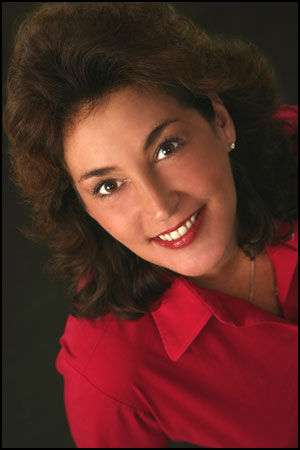
Here's one of the all time most important "pieces" of the "photography success puzzle."
Whether you have a store front photography studio on main street or work out of your home, here are eight key points to making top money with your photography business.
Marketing & Selling Key Point #1. You sell what you show.
This seems so obvious, but unless someone constantly reminds you of this, you can forget it. In our photo biz, the big money, 80% of our profits, come from helping our clients become happily involved with wall portraits as home décor. If you’d like to do the same, then it’s vitally important you not … show anything in your photo business that is smaller than a 24×30.
No 8×10′s or 5×7′s in frames sitting on tables. No groupings of 8×10′s and 11×14′s on the walls.
Now, I know what you may be thinking. “But Chuck, how do I show off all the variety we offer our clients?” Well, you do that by having a sample book of 8×10’s or 11×14’s – each sample book is of ONE PARTICULAR SESSION TYPE – for example, you have one for seniors, one for families, one for children, etc.
Then, all you do is bring out the ONE book of the particular client type with whom you are meeting. Don’t have all the books sitting out in the studio. Only have the one book that applies to this client.
This way, when she first walks in, your client only sees beautiful wall portraits on the walls, and nothing else.
Marketing & Selling Key Point #2. The first impression is the lasting impression.
Really, everything we’re going to talk about deals with this law.
That’s the major reason we put wall portraits in our studio. That’s why we dress nicely for our clients. We only get one chance at a first impression.
But what I mean here is that you want your studio to look like you are successful. Remember, “NOTHING SUCCEEDS LIKE SUCCESS.” If you want to BE successful, you must FIRST LOOK successful.
Now, I don’t mean you have to go out and buy all new furniture for your photo biz, and a new car, etc. But what I do mean is that you want things to look like you are really successful.
Simply take everything that doesn’t look “successful” out of your studio client areas. You don’t want anything to distract from the feeling of success. For example, don’t have any camera equipment, mail, props, bare prints, etc. laying around. This is clutter. And that kind of clutter does not “say” success.
What “says” success is having everything very neat, clean, orderly.
Having nothing out in the “lobby” or other “client areas” that isn’t absolutely imperative to the look and feel of the environment.
Just to be clear, I’ll say it again: everything I’m saying here applies whether you have a store front studio, or have a studio in your home.
Marketing & Selling Key Point #3. Have your studio look like a home.
You want your studio to look and feel like a home. You want “home” type furniture around. This does two important things:
First, it helps a client feel comfortable when she walks into your studio. And if she feels comfortable, she will be much more likely to work with you, and invest in more photographs
Second, it helps her immediately see how nice your fine photography looks on the walls of a home. She can think to herself, “Gee, I have a sofa about that size in my home. Boy, a portrait would look nice over that sofa, just like it looks so nice here….” That’s the beginning of wall portrait sales.
Marketing & Selling Key Point #4. Keep the colors in your studio very soft and muted.
You want your portraits to be the most colorful items in your studio.
So, if you specialize in color portraits, I highly recommend you keep all the other tones in your studio very soft, such as off white, or beige, and soft golds, etc. You want the eye of the viewer who walks into your studio to go immediately to your beautiful portraits on the wall.
Marketing & Selling Key Point #5. Don’t have samples of different sizes of the same image.
Don’t get trapped into this one! Many photographers, who don’t know better, take one family portrait, and print it in all sizes, from 11×14 up to 24×30. They then hang them side by side, so people can see the differences.
All this will do is confuse your clients, and sell you a lot more of the small sizes. Simply use the projecting to show the clients what the different sizes look like – using the client’s portraits.
Marketing & Selling Key Point #6. Never, ever have photos sitting on the floor.
I understand that as an “artist” you want to have lots of different images available to you to show perspective clients. You want them to see how versatile and creative you are.
However, don’t do it. Not if you are dead serious about making MORE money with LESS work. Have each of your wall portraits beautifully framed, and presented on the wall, where they belong. Do NOT ever set photographs on the floor, leaning up against the wall. This is totally disrespectful to your work, and conveys non-verbally to the client that you do not place a high value on your talent and imagery.
Marketing & Selling Key Point #7. Each photo must occupy it’s own plane of space.
You want each portrait on the wall to occupy it’s own plane and space.
(I learned this from the great photographer and salesman, Ken Whitmire.) By this, I mean that you don’t want to have two 30×24’s hung side by side in your studio. Because both of those images would be occupying the same “plane” of space. It will be a hundred times more powerful and “artistic” to take those two images down, and replace them with only ONE 30 x40.
Now, sometimes, you will have a long wall, which has a door in it.
Okay, now you can display one wall portrait on one side of the door opening, and another wall portrait on the other side of the door opening. Because the door “breaks” up the single plane. You also can use potted plants, small trees, etc. between wall portraits on a long wall.
Marketing & Selling Key Point #8. Be sure your portraits are well lit
Always have some effective lighting, either in the ceiling, or track lighting hung down from the ceiling. In our studio, almost the ONLY lights in the client areas, are lights which are aimed at the wall portraits. Remember, you want your portraits to be the brightest items in your studio.
Also, NEVER, EVER have ANY fluorescent lights in your client areas.
Remember, you want your studio to look and feel like a home environment.
I hope this has helped remind you of some of the important aspects of your studio design. Do this correctly, and prosper beyond your wildest dreams! Do this incorrectly, and work way too hard for way too little money. It’s that important.
All the best,
Charles J. Lewis




